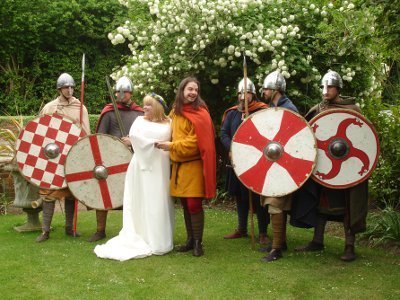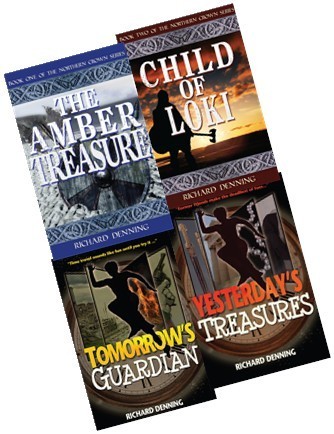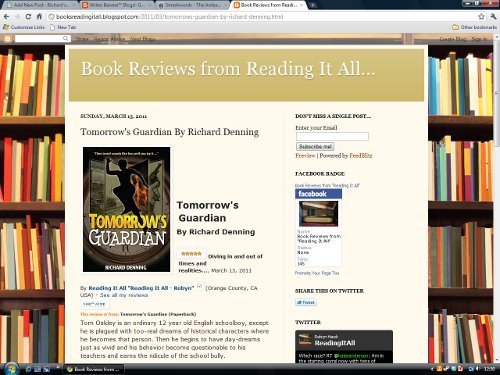Richard Denning's Blog, page 20
June 10, 2011
How to set about researching Historical Fiction
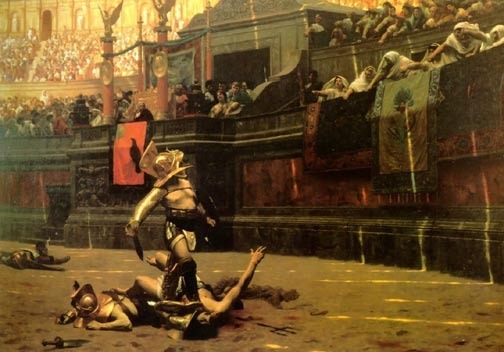
I write historical fiction and fantasy novels because those are exactly the type of novels I also enjoy reading. If you are considering writing historical fiction here is a quick gallop through the process and the decisions to make.
What to write?
Firstly you have to consider these questions:
•Should you write what you know?
•Should you write what what you love?
•Should you write what YOU would want to read?
My view is that you can write about anything BUT you must been enthusiastic and fascinated by the subject because if you are not moved by it WHO else will be? If you are sufficiently enthused by 11th century Croatia you will go out and read all there is to find about it and in time BECOME an expert on it and so what you LOVE is now what you KNOW.
Why write Historical Fiction?
Here are some reasons to consider choosing to write historical fiction novels:
•Because you love history and historical periods.
•You have the whole of human existence to choose from.
• History is full of colourful backgrounds.
• There is a wealth of fascinating and interesting characters to include.
• Plots can often be suggested or flow from real historical events.
What is the competition
Before you spend years reading up on a subject it is wise to check the market first. Go and visit a book shop and see what is on the shelf. See what is popular at present. Browse Amazon and check out the bestseller lists for historical fiction. There is a really useful website http://www.historicalnovels.info/ which lists 5000+ novels (including mine
 ) you can check the different time period and see what has been written already.
) you can check the different time period and see what has been written already.Consider who the story is about
•A real Person and Real Historical events – which is almost biographical.
•Fictional Person but real history. EG a made up character at the battle of Hastings
•Real person in fictional story. EG Napoleon leads an invasion of China.
•Fictional person and fictional history (but set in an authentic setting) Maybe Richard Sharpe in a fictious battle in Spain.
OK lets hit the books
The one biggest problem (and joy) about writing historical fiction is that you have to do a LOT of research. You sinply have to get the facts right or you will come unstuck. So (amongst many other things) when thinking about the people in your book think – can you answer THESE questions:
•What did they wear?
•How did they speak?
•Where did they live?
•What did they eat?
•How did they fight?
•What did they care about?
•Where then can we find out all this stuff out ??
Even in these digital age there is a LOT can can be learnt (and in some cases ONLY learnt) from books, maps, documents such as birth, marriages and death cerificate, ship manifests, wills, school records, old trade directories etc. Your local library can help you start out but you may well need the services of a larger central library, a focused one such as the libraries in the National Maritime centre at Greenwich or the Public record office. If you are serious about writing historical fiction you will quickly develop a library at home. Check out second hand book shops and even car boot sales to pick up some general purpose reference material but you will have to visit a book shop or Amazon and other online sites to source more detailed books. I write about 6th century England and had to find some VERY obscure books by trawling the internet. Many museums will have a number of books for sale on their subject area and I always check out museum shops.
The Internet is now the single largest source of material on the planet and like it or lump it writers have to use it. You Tube has a wealth of really useful videos. Want to know how to load a Brown Bess musket? Watch a video about it. How to put on a toga? How does Tiger Tank sound when it fires – its all on there too. Facebook is the largest source of images world wide. Join groups relevant to your subject area and get involve din discussion. When I was trying to find a likely place for the lost 7th century battlefield of Degsastan I found a small forum dedicated to early Scottish history. Wikipedia is good start point as a general encyclopaedia BUT take it with a pinch of salt and check additional sources as it is not ALWAYS rght. Google images is great for pictures of pretty much everything as well a a large number of useful maps. The internet should also be your starting point for planning trips to other libraries, battlefields, museums and living history centres.
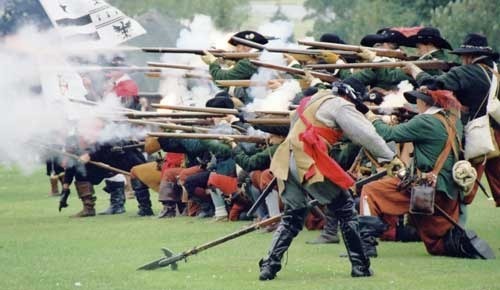
Which brings me onto the next area critical to good research. Get up, leave the PC behind and get out. Go to museums, visit living history centres and re enactments of battles. Get into the car and drive to a battle field. Walk the streets of Pompeii. Stand where Napoleon stood and see what he saw at La Belle Alliance. The walk across Waterloo field and stand where Wellington did when twenty thousand French cavalry were charging the British Squares. NOTHING replaces actually being there.
If you do all this you should now have the facts and figures, the images and maps that will enable you to write authentic and believable fiction. How to plot your book?? Ah well that is for another article …
For an example of my historical fiction try The Amber Treasure. You can read the first part on my website for FREE.

May 22, 2011
2011 Middle Earth Weekend Sarehole Mill
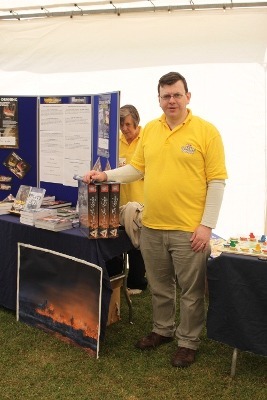
Ready with my books and game
This weekend I visited Sarehole Mill. This is a 17th century watermill which when built would have been in rural Warwickshire but now a days is in a suburb of Birmingham.
J.R.R. Tolkien lived within 300 yards of the mill between the ages four and eight, and would have seen it from his house. He has also said that he used the mill as a location in the Lord of the Rings.
"It was a kind of lost paradise … There was an old mill that really did grind corn with two millers, a great big pond with swans on it, a sandpit, a wonderful dell with flowers, a few old-fashioned village houses and, further away, a stream with another mill. I always knew it would go — and it did. – said Tolkien in an interview with Guardian journalist, John Ezard in 1966, before the mill's restoration.
Now pictures of the mill will have to wait for another visit because I did not see it this weekend (although I have visited a number of times in the past and actually worked at a practice in the area in the 90's). Instead I spent most of the weekend in a marquee!
For this weekend was Middle Earth weekend – a celebration of all thing Tolkien on a site out the back of the mill in an area with lots of Tolkien links. Moselely Bog – the inspiration for the midgewatermarshes and the Old Forest is just accross the road as is a house where Tolkien lived.

The MIddle Earth Weekend
Half a dozen Marquees were constructed on the ground along with a couple of dozen tents belonging to Viking Reenactors. There was a craft tent, performance tent with readings from the works of Shakespeare and poet and a market selling reenactors costumes, plants, craft goods and several food outlets.
The event had a good attendance of several thousand. I have been for several years now aiming to promote UK Games Expo and last year and this with my books as well.
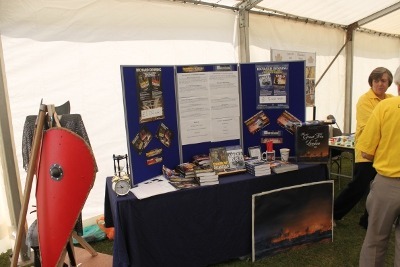
Bookstall
This year I had my 4 books on sale. To help advertise The Amber Treasure one of my friends who used to be a reenactor brought his armour and weaponry from his days as a Viking warrior. My trsuty Hourglass and Tom Oakley's Alarm Clock also featured and long with the Great Fire of London Painting. These sorts of occasions are attended by a mix of people but some at least are into Fantasy and History and so my books seem to go down quite well. Indeed it was this event last year where I really launched my books for the first time.
I had lots of interesting conversations with people and did sell a number of books.
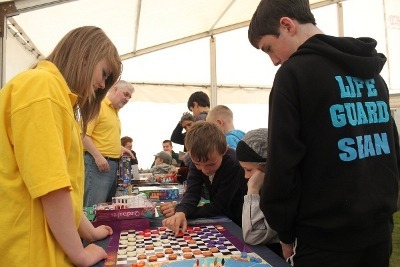 The event was also our last publicity event for UK Games Expo. We took along twenty of the new games that will come out at the show in 2 weeks and played them with many people as well as giving out flyers and talking to them all. Hopefully many will come along to Expo – and the Middle Earth Weekend has always proven to be a great event for us.
The event was also our last publicity event for UK Games Expo. We took along twenty of the new games that will come out at the show in 2 weeks and played them with many people as well as giving out flyers and talking to them all. Hopefully many will come along to Expo – and the Middle Earth Weekend has always proven to be a great event for us.
IN this shot you can see my daughter and in the middle ground Pat (one of the other Expo directors) whilst (in the distance) our Lord of the Rings Game being played.
This is a combined effort with my wife, daughter, parents, fellow directors and also brilliant helpers Richie and Mike running the Moria game (and providing the armour!
In our Amon Hen game the Fellowship has broken and Frodo must reach the river from the top of Amon Hen. the Fellowship have to fight off the orcs and given him a chance to get away.
I was only able to take shots in quiet moments. Some times a great surge of people would enter in one go and it would be all hands to the pumps to try and talk to as many as we can. I learnt several years ago that you have to leap in and start talking and hopefully most folk will respond to your subject if you make it interesting enough.
I have been at book fairs and games fairs where people dont talk to the visitors. Guys you HAVE to engage them. You cant just sit back and hope they will come to you.
With the games we aim to have mostly simple, attractive and easy games. I love complex games but a lot of people are terrified of games. They say "oh that sounds complicated" or – grinds teeth – is that like monopoly? If you start to explain more than 4 rules they head for the door. So one learns you have to coax folk in with easy games and not hit them with the heavy weight ons until they are ready for them.
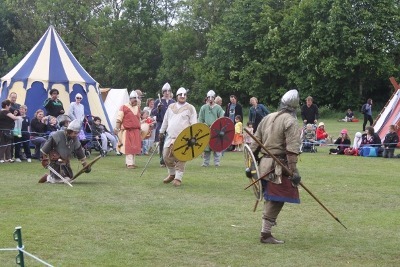
Vikings in combat
Another cool thing about this weekend is the amount of reenactors who attend. Hopefully some of the Vikings will turn up at UK Games Expo in 2 weeks time.
In this shot we see a battle in the arena. The did a number of these duing the weekend as well as having a village with Viking tradesmen showing how they made weapons and clothes, bread and shoes 11 centuries ago
The Middle Earth weekend is a wonderful escape for me from the concerns of day – a chance to just enjoy meeting people, talking about books and games, drinking traditional lemonade as well as a rather nice curry from another stall and just relaxing. I do believe though that these occasions should be in the list of events to think about for an author to visit – if you can see an overlap with your subject matter then it can prove a good way to raise attention for the books.

May 8, 2011
Anglo Saxon words in modern use
The Language of the Anglo Saxons
by Richard Denning
Old English
The Anglo Saxon's used a language called Old English which evolved out of Old German – the language spoken in the homelands in West Germany. Old English was in use between the 5th and 11th centuries when it merged with Norman French and produced middle English – the language of Chaucer.
Old English looks and sounds VERY alien to a modern English speaker. Here is a reading of the Lord's Prayer in Old English:
Here is the text in Old English and Modern English:
Fæder ure þu þe eart on heofonum;
Si þin nama gehalgod
to becume þin rice
gewurþe ðin willa
on eorðan swa swa on heofonum.
urne gedæghwamlican hlaf syle us todæg
and forgyf us ure gyltas
swa swa we forgyfað urum gyltendum
and ne gelæd þu us on costnunge
ac alys us of yfele soþlice
Translation of the Old English Text:
Father our thou that art in heavens
be thy name hallowed
come thy kingdom
be-done thy will
on earth as in heavens
our daily bread give us today
and forgive us our sins
as we forgive those-who-have-sinned-against-us
and not lead thou us into temptation
but deliver us from evil. truly
Whilst much of modern English comes from the French brought by the Normans, the majority originated in an older form of English. This then is how our ancestors would have sounded.
Much of Old English survives in names for our days and our towns.
Anglo Saxon Day Names
The Germanic races took the Roman day names that they encountered with dealings with the Roman Empire and translated it into Old German, Old Norse and ultimately Old English. They replaced the Roman gods with there own (with the exception of Saturday).
Modern English day
Old English day
English day meaning
Latin day name
Latin day name meaning
Monday
Mōnandæg
"Moon's day"
Dies Lunae
"Day of the Luna"
Tuesday
Tiwesdæg
"Tiw's day"
Dies Martis
"Day of Mars"
Wednesday
Wōdnesdæg
"Woden's day"
Dies Mercurii
"Day of Mercury"
Thursday
Þūnresdæg
"Thunor's day"
Dies Iovis
"Day of Jupiter"
Friday
Frigedæg
"Frija's day"
Dies Veneris
"Day of Venus"
Saturday
Sæturnesdæg
"Saturn's day"
Dies Saturni
"Day of Saturn"
Sunday
Sunnandæg
"Sun's day"
Dies Solis
"Day of the Sun"
Anglo Saxon Town and Place Names
Many elements in our modern English place names ultimately come from Anglo Saxon place names. Often a name would combine a reference to the owner of the land and some description about it.
Here are some common elements in place names:
barrow a wood
burna (-borne) a brook, stream
burh (modern word – borough) Fortified town
combe Small valley
ford a shallow river crossing
dun – a hill
eg (-ey) an island
halh – a nook, corner of land
ham – a homestead
hamm – an enclosure, water-meadow
hurst wooded hill
ingas (-ing) the people of …
leah (-ley) a clearing
stede – a place, site of a building
tun – an enclosure, farmstead
well – a well, spring
wick Farm or dwelling
worth – an enclosure, homestead
Here are some examples of Old English place names and the modern name and what it means:.
Birmingham
Beorma+inga+ham
enclosure of the sons (or descendants) of Beorma
Oxford
Oxon Ford
Place where Oxon can cross the river
Warwick
Weir+wic
Dwelling by the weir
Hastings
Hæst+ ingas
Hæsta's people
Hertford
Hart+ford
Place where stags forded the river
Cantley
Canta + leah
Canta's clearing
Downham
dun + ham
Hill village
Elmswell
elm + wella
Elm-trees' spring
Wortham
worth + ham
Homestead with enclosure
Colby
Koli + by
Koli's farmstead
Westhorpe
vestr + thorp
Westerly outlying farmstead
Stanton
stan + tun
Stony farmstead
Gisleham
Gysela + ham
Gysela's homestead
Anglo Saxon Months
The Anglo-Saxon year was originally divided into twelve lunar months (which mean 'moons'), but this created a problem because a lunar cycle is about 29.5 days. The results was a 354 day year. After only a few years the lunar and solar months would be out of alignment. To get around this issue the Anglo-Saxons would have leap years and would insert an extra month into the summer. THe summer was one long 2 month period called liða, roughly corresponding to June and July.So the leap years was called Ðriliði (three liðas).
The year began on Modranecht, Mothers' Night, the 25th of December. This festival was later adopted as the date for Christmas in the typical pragmatic style of the Church. Its possible that Anglo- Saxons honoured female ancestral spirits on this day.
December and January were both called Giuli, or'Yules'. Yule, was the name for the winter solstice period – the shortest days in the year when the anglo Saxons would drive away the drakness by feasting. December was roughly equivalent to Ærra Geola, or 'before Yule', and January was Æfterra Geola, 'after Yule'.
February was known as Solmonað or 'Mudmonth'.
March was Hreðmonað possibly named after a goddess Hreða of which we know little.
April corresponded with the lunar month of Eostermonað named again after an obscure deity called. This month has survived into modern times as the word Easter which is typically celebrated in March or April.
May was Ðrimilcemonað, 'month of three milkings'. "So called because in this month the cattle were milked three times a day," commented the 7th century historian Bede.
As has been said June was known as Ærra Liða, 'first' or 'preceding' Liða and July was Æfterra Liða, 'following Liða'. The word Liða might mean sailing as this was the time of year when sailing was easiest due to calm weather. So this was the summer sailing season.
August was called Weodmonað, 'weed month' probably because weeds and crops wwere growing fast.
September was Haligmonað, 'holy month'. It was a time to give thanks to the gods for the fruits of the summer harvest. Harvest festivals stll survive in many countries into the modern period.
October was Winterfilleð – the begining of winter.
November was called Blotmonað. This many have been a month of sacrifices BUT more likely it was the time of year when the animals would be saluaghtered and preserved for the coming winter feasts.
Material on this page is sourced from Omniglot Wikipedia and

May 6, 2011
Hindenburg Disaster May 6th 1937
Today is the anniversary of the Hindenburg disaster in 1937. This event appears in Yesterdays Treasures. Here is the excerpt.
[image error]
Chapter ten – Hindenburg
Tom stretched out both his arms. Edward and Charlie each placed a hand on one and Mary and Septimus on the other. In his mind Tom brought up the Map. He scrolled across it to find the eastern seaboard of the United States. Once there he located the naval base at Lakehurst. He focused upon it and Walked in that direction. As he moved, he brought into his mind an image of the Clock – his brass alarm clock that had once belonged to his father. He spun the timepiece's hands backwards, moving them faster and faster until he knew he had reached the target date and as he did, he Walked them all back through time to May 6th, 1937, a few minutes before seven p.m. local time.
They materialised in the gap between a warehouse and some packing cases. Septimus popped up to take a look over the top of one and glanced about then turned and beckoned for Tom to join him. Tom peered carefully round a box labelled 'J.P. Sutton – Machine Tools'. Beyond the cases, and only a few feet in front of them, was a wire fence about twelve feet high and through it he spotted two enormous hangers running off to their right. Ahead and to the left was a large open space with marked out runways and a windsock fluttering in the breeze. On the far side of the landing field, more huge hangars loomed. To their left and about two hundred yards away, in the middle of the large open landing field, was a tall structure made of steel girders. Much like the Eifel Tower, but actually shaped a bit like a rocket, it rose to a point high above them.
"I have been here before," the Welshman whispered. "A few years prior to today, in fact; I was … ahem, borrowing some secret plans. Anyway, according to memory, those hangers house the airships when they are not in flight," Septimus pointed at the vast buildings. "The Americans had several naval airships based here I believe, as well as it being the landing field for the Hindenburg. Now, look over there everyone," he gestured.
They all stared at the huge tower.
"That's the airship mooring mast. When the Hindenburg arrives, it will come in and descend so that it is level with the top of the tower. It will then dock with it and be winched down to ground level. That at least is the plan. Of course, that never actually happens, because, whilst the ship is approaching the tower the disaster occurs and she burns and crashes."
"Good Lord, there she is!" Charlie exclaimed.
They turned to see the airship approaching from behind them: an impossibly large cigar-shaped balloon hundreds of feet above them, but still vast, casting a giant shadow over the airfield. She was a metallic blue colour all over, with the exception of the glass windows in the control car at the front and the promenade windows of the passenger deck at the thing's belly. Prominently displayed were red and black swastika flags painted onto the fish like fins projecting out of her rear end. Eerily, her approach was almost silent.
Tom heard a loud sob and turned to see Mary staring up at the Hindenburg, one hand over her mouth and the other clutching at Septimus. "I am frightened, Mr Mason. What demons drive that creature, what magic can make it fly?"
"Mary, don't get upset. It is a thing; a machine that men make. There is no monster within it – just engines," Septimus explained, but Tom could see Mary was far from convinced and she kept on staring at the airship as it moved by. Did she see it as yet more evidence of incomprehensible things beyond her time – a time she was perhaps never meant to see? Exchanging worried glances with Edward and Charlie, Tom placed his arm around her waist and gave her a comforting squeeze. He could feel her whole body trembling and knew she was struggling not to weep.
"Mary, you don't have to come. You can stay here and we'll pick you up later."
"No, Master," she said firmly, letting go of Septimus and dashing a hand across her face, clearly making an effort to regain her composure. "Forgive a moment's weakness. I will be fine now, I swear it."
Relieved to feel that she was no longer shaking Tom gave her an encouraging smile and withdrew his arm.
The Hindenburg was still high up and well above the mooring tower. As it passed over the top it turned to the north and then to the west and now Tom could see that it was descending slowly as it curved around and began to come back towards the east – back towards them and the tower.
Septimus checked his watch, "Right, it's about fifteen minutes before the disaster. Time to get on board. Tom, take us into the superstructure near the crew compartment's access door to the aft gangway.
Tom nodded and tried to hide the doubts he was feeling. He was glad he had taken careful notice of the Professor's plans, but had he paid enough attention to the details? What if he got it wrong? One of them could end up outside the airship or inside one of the gas cells. Then, of course, it was not just a question of recalling the layout correctly. If whatever had afflicted him the previous day happened again they might all end up in the middle of the sea for all he knew. The lives of his friends were in his hands and the enormity of the responsibility made him falter.
"OK Tom?" Septimus hissed. "No time to hang about, boyo!"
Shaking his head in an effort to dismiss his gnawing anxieties Tom frowned in concentration. They had only minutes on this job and he had to get it right. In his mind he brought up the Map and then, having made sure he was anchored to the location at Lakehurst, he superimposed the floor plan of the airship, orientating it in his mind so it matched the alignment of the real ship above them. There, just behind the hatch into B-deck, was a corridor. But it was a narrow space, only wide enough for one person, so with a hurried explanation, Tom had his companions form up in single file then positioned himself in the middle of the line. He nodded to the others and they reached out to touch his outstretched arms then, with a final nod, he Walked them away.
They materialised in the corridor running along the keel of the airship, which was formed within a triangle of steel girders. A narrow gangway led in two directions within the triangle, whilst outside the girders there were huge sheets of whitish canvas. Tom realised after a moment that these were the gas cells and that he and his friends were surrounded by thousands of tons of hydrogen: the gas that fuelled the sun. A single spark might turn it all into an inferno. He gulped and looked along the walkway.
From one direction down the corridor the whirl and clunk of machinery could be heard. "Generator room in the heart of the ship: that's aft of the cabins. Come on, this way," Septimus muttered and led them in a single file away from the generators. On either side of them they now saw a series of cabin doors. Septimus held his finger to his lips to keep them quiet and hissed two words, "Crew quarters," before carrying on along the corridor.
Beyond the crew quarters, a large steel door blocked their path: the rear hatch leading into B-deck.
Septimus looked round to check they were all still with him and glancing at Tom he raised a questioning eyebrow and tapped his watch.
"It is now seven-fifteen local time," Tom said. "Assuming the Professor knows what he is talking about and the stone tablet is also correct, then these pearls we are after will begin to change into the fragment of the Crown in eight minutes. The fire starts in, er … ten and then in two minutes more, the ship is destroyed."
"Right then. Charlie, Mary and I will go and try to get into the Captain's safe. Tom, you and Edward go to the passenger cabins and look for the pearls there. If we fail to find them, we meet up here in ten minutes. All clear?"
"As mud!" muttered Charlie.
"Excellent," replied Septimus. "Right, let's go!"
Cautiously, Septimus opened the hatch and peered around it. Beyond the doorway, the corridor extended forwards about fifty feet before ending at another hatchway. More doors led off the passageway on either side. Septimus allowed Mary and Charlie to pass by him into the corridor. He went to follow them then suddenly he slapped his forehead, turned around to face Tom and Edward and frowning, pointed up at the ceiling.
"Damn!" he exclaimed. "I just remembered that you can't get to the stairs from here without going through the Purser's cabin and the bar. The bar is through the smoking room airlock and will be manned by the barman. You two are going to have to Walk up through the ceiling."
Tom nodded and imagined the plan of the airship in his mind. Directly above them he could picture the hallway at the top of the stairs from B-deck, which was the entrance to the passenger cabins. "Ten feet straight up," he instructed his companion. Edward nodded and they both Walked to the landing.
On either side of them, stairs led downwards. Beyond these were doors to the dining room, on one side of the ship, and the passenger lounge on the other. Directly in front of them two corridors ran between the passenger cabins. A moment after they had appeared, a smartly dressed man in a jacket and tie strolled out of one of the corridors examining a camera he was holding. He pushed past with barely a glance and then turned to take a second look at them.
"Guten Abend, wie heissen Sie?"
"Er, Ich heisse Herr Edward Dyson," Edward said in hesitant German.
"Ah, you are American? Why have I not seen you before?" the stranger asked, switching to English.
"English, actually but we have both been ill, only just come out of our cabin."
The German gentleman looked doubtful at that answer, but shrugged and walked on towards the lounge. "Well, we are just landing," he said over his shoulder, "so I would hurry yourselves: you don't want to miss that do you?"
After he had gone, Tom let out the breath he had been holding and Edward nodded at him. "Phew, I thought he might raise the alarm. Come on, let's go – we can't have long now."
"Just nine minutes to go," said Tom, turning to peer towards the cabins. "Which corridor?"
Edward shrugged and then rushed across to one of the openings and glanced along it, his gaze taking in the nearest of the doors on one side and then the one opposite it. "We want number 17 don't we? These are 1 and 14 so not this corridor," he announced moving to the other entrance. "Here's 15 to 28. Come on, it's this way."
Tom ran after his friend, counting off the cabins as he passed them: "15 … 16 …"
"Ah, 17, this is it," Edward announced, giving a gentle tap on the door, his ear pressed against the polished wood. "Thank goodness, no one there," he said after a moment, his hand twisting the doorknob. "Blast! Locked," he muttered and then stepped back, steadied himself and hurtled into the door like a rugby forward putting his weight behind his right shoulder. With a great crack followed by a splintering sound, the door was knocked back off its hinges.
"You don't think it might have been easier to Walk?" Tom muttered with a wry grin.
Edward shrugged and just smiled. "Maybe … but it wouldn't have been as much fun."
Beyond the shattered doorway the cabin was tiny: only six feet long by about five feet wide. On their left they could see a wash basin and a curtain that led to a small closet. Ahead of them was a fold-down table and a stool. Finally, on the right, was a bunk bed complete with a ladder leading to the upper bunk. On the lower bunk Tom spotted a suitcase.
Edward had seen it too and tried the catches. "Locked!" he grunted. "Try checking the closet, hurry we have only eight more minutes," he added, pulling out a penknife and flicking out a blade.
Tom poked his head through the curtain, but the shelving inside was bare. Frau Denitz had obviously packed her clothes away in the case.
Edward, meanwhile, had pushed the point of the blade behind the lock and twisted. With a snap the catch flew open. He repeated this manoeuvre on the other side then he tipped the case upside down. Shirts and blouses, trousers and skirts fell out of the case and tumbled on to the blanket covering the lower bunk. Two small boxes fell out as well: one bouncing on the bed to land on the floor. Tom bent over to retrieve that one, opening it hopefully, but then grimaced when it turned out to contain only a fountain pen. Edward opened the other to reveal a string of shiny and very beautiful white pearls. Tom grabbed the jewellery and grinned at Edward.
"Eureka! Found it!" Tom said. "Quick, let's go."
He turned to exit the cabin and then froze, for there, in the corridor outside, stood a man. He was somewhat older than the young lieutenant – perhaps about the same age as Septimus – clean shaven but with a shock of red hair. He wore army style canvas trousers and a Chelsea football top. There were two striking things about him, other than his hair. Firstly, the football shirt was from the recent 2009 to 2010 football season and secondly, he was holding a pistol.
"I'll 'ave that mate!" he said, speaking with a London accent, cocking the revolver and pointing it at Tom.
Chapter eleven – Rolf Lapace
Edward Walked: vanishing from where he stood next to Tom and appearing in the corridor beside the stranger, his fist going back ready to land a punch on the redhead's face. Edward blinked, gasping as he saw the man was no longer there, but had vanished the instant Edward materialised.
Tom was about to join Edward when he felt a pistol barrel dig into the back of his neck. With a chill he realised the man was now right behind him and that he too was a Walker.
"Nice try, sunshine!" said a voice in Tom's ear. Reaching over, the redhead seized the string of pearls and with a pop, was gone.
Edward slammed his fist against the wall in frustration, "Damned cheek! Who the devil was that chap?"
"I have no idea, but he's got the pearls and it's less than two minutes before they become the fragment." Tom frowned as a thought occurred to him, "Tell you what though, whoever he is, if like us he's after the Crown, he won't leave until the fragment appears."
Edward closed his eyes and screwed up his face in concentration then nodded. "You are quite right, Tom. He is still on board. He is … oh my … he's in the Captain's cabin!"
Tom's eyes widened, "The others: come on, let's go!" he yelled and without waiting for Edward, he Walked down through the vessel to the keel corridor near the bow of the airship, above the control car and just outside the Captain's cabin.
As they materialised, Edward gave a cry of alarm, seized Tom and yanked him sideways. An instant later, Septimus tumbled out of the doorway, blood streaming from his nose. Without hesitation, Edward rushed into the room followed by a slightly more reluctant Tom, to find themselves face to face with two huge men.
Both were at least six foot six inches tall, bald-headed, wore boiler suits and appeared to be identical twins. One of them, his face bearing a scar above the right eyebrow, had presumably just punched Septimus, for the other had Charlie in an arm lock around his neck and was squeezing the sailor's throat. Charlie was clawing at the man's hands, choking and struggling to get free. A third man – the redhead in the Chelsea shirt, who was clearly the leader of the trio – was pointing his gun at a terrified Mary, who stood cowering beside the Captain's desk.
As Tom and Edward burst into the cabin, the redhead swung the pistol round to cover them and in that instant Tom saw that the door of the safe was hanging open, its contents strewn across the desk. Amongst them was a jewellery case.
"Now now, gentlemen, no need to take any risks," the leader waved the gun from Tom to Edward. "We all want to get off this airship alive, don't we?" He glanced at the huge twins, "Orme, get the pearls!"
The big man with the scarred face grunted and stepped towards the desk, but at that moment, Mary lunged for the jewellery case. The leader swung the pistol back and again the silenced weapon pointed at the girl.
"Don't try my patience, lass. I warn you: I will shoot if I must," the man threatened, frowning as Mary flung her arms upwards and screamed, "Wall!" There was a flash of light and surrounding her now was a shimmering shield of frozen time.
"Nice trick, lass!" the leader said and with a mocking grin he Walked, appeared on top of the desk and pushed Mary roughly to the ground, the shield disintegrating as she fell. Seizing the jewellery case, her assailant jumped down and an instant later the gun was once more pointing first at Tom then at Edward. They exchanged a despairing glance: they had not had a chance to move; Charlie was still struggling and gasping for breath … and the seconds were ticking away.
"Right! Orme, Jez we have them both. Back to location Y," the redhead ordered and the three of them were gone.
Septimus staggered back into the room, blood still streaming from his nose, whilst Edward ran over and helped Mary to her feet and Charlie stood coughing, one hand massaging his bruised throat.
"Where are they?" Septimus asked turning to Edward.
"Gone … to the rear of the airship," Edward shouted. "Around ring 62, I think."
"What do we do now?" Charlie gasped.
"Get us after them, Tom!" Septimus snapped.
"It is only seconds before the pearls … whichever set it is, becomes the fragment," Tom warned. As he spoke, the sound of bellowed orders and the clattering of running feet echoed through the open doorway as a group of men hurtled down the corridor towards the front of the ship.
Septimus leapt to the opening and quickly closed the door, but stood holding the handle in case anyone should try to enter. Whoever they were though they did not stop at the Captain's cabin, but carried right on by. "Those are crewmen running towards the bow to help straighten up the Hindenburg," he explained. "The Captain had some difficulty keeping it straight and he used their weight to level it out. That was only just before the fire. In other words, we don't have long: come on Tom, NOW!"
Tom Walked them all back through the ship to the corridor near ring 62. It ran into a dead end just behind them – the very rear of the ship. On either side of them were long, white, oval-shaped canisters the size of coffins – ballast tanks, Tom thought. Above them a ladder ran vertically up through the ship between the gas cells. A few rungs up the ladder, still holding his pistol and pointing it at them, was the red-headed man in the Chelsea shirt. Higher up the twins were hanging on to the ladder, each holding out a single set of the pearls they had stolen.
"Just stay there, Septimus," said the redhead. "No need for a fuss. I only need a few seconds more."
Tom gaped at Septimus: the fact that this man knew the Welshman by name came as a great surprise and not just to Tom judging by the shocked faces of his companions. They all turned to look at Septimus.
The Welshman paid them no heed. Glaring up at the stranger, his face twisting with outrage, he spoke at last. "Damn you, Rolf Lapace! I thought we agreed to keep out of each other's way."
The other man snorted. "Yes, well, IF you recall the conversation, what we actually agreed was to avoid competing for the same contract. It seems that you and I are working for different employers who are apparently both interested in the same item just now. I appear to have possession of that item – one of these," he gestured at the two sets of pearls dangling above his head. "We will see which one in a moment – so don't try anything stupid. I would hate to have to shoot an old pal! It might cause an explosion," he laughed.
"Keep him talking, I'll get up there," Tom whispered to Septimus and he slid back behind the Welshman and out of sight. Then, as he Walked, he felt Mary slip her hand onto his elbow. They materialised side by side on the ladder directly above the uppermost one of the big brutes – the scar-faced one: Orme, thought Tom; the lower one must be Jez.
When they appeared, both he and Mary clamped one hand onto a rung to steady themselves. The sudden noise drew Orme's attention and he glanced up at them, but not quickly enough to prevent Mary from reaching down to grab the pearls. He swayed, almost overbalancing, slack mouth falling open in his brutish, unintelligent features.
"Boss!" Orme's very deep voice boomed.
Lapace looked up to where Tom and Mary balanced precariously on the ladder. He whipped the pistol round and without hesitation fired a shot. The bullet missed Mary by an inch and there was a ping as it ricocheted off the rung next to her head and flew away.
"Lapace, you fool!" Septimus yelled, "The whole ship is full of hydrogen!"
As if in response to those words there was a muffled explosion above them. Tom glanced upwards. The ladder upon which he, Mary, Lapace and his grunts clung ran up above his head, emerging in another corridor – the axial one that ran though the very centre of the airship. Another ladder ran up again from there to the top of the airship and ended at a ventilation shaft that led out onto the external surface. There – high up at the top of the Hindenburg – a gas cell had been punctured and, as Tom looked on with horror, it suddenly erupted into flames.
"Oh, my God!" he yelled as the fire spread down towards them.
Still clutching the string of pearls, Mary held out her hand and grunted in concentration. Just as she had done once before in Pudding Lane, she held the flames at bay. However, the fire in 1666 had not been fuelled by thousands of tons of hydrogen. Sweat collected in beads on her forehead as she struggled to contain the ball shaped inferno that threatened to expand and incinerate them along with the ship.
Biting his lip, Tom stood as if paralysed, watching whilst the fireball glowed and flickered like a miniature sun that would devour the Hindenburg in just a few brief moments. In the last few months he had faced death on more than one occasion, but never had it been more terrifying.
Just then he heard a new sound: a strange screeching, like someone running their nails down a blackboard. Distracted by the fiery globe only thirty feet above his head, it took Tom a moment to realise the sound was coming from below, not above. He glanced down and saw that the string of pearls in the hands of Orme's brother, Jez, was glowing intensely. All eyes were drawn to it as the sounds and the glowing lights seemed to reach a crescendo. Then Tom saw that Jez no longer held a string of pearls, but instead he now clutched a shard of metal. Tom recognised it instantly as a piece of an ornate crown: the Crown from his dream.
"Sorry lass," Lapace drawled, "bad luck and all, but it looks like you've got the wrong one there," he taunted. "Let's go boys!"
The three of them vanished away from the Hindenburg, leaving Mary holding a string of beads; just an ordinary set of pearls. She was pale as snow, her brows drawn together as she swayed on the ladder, her strength almost at an end. The fireball began to inch towards them.
"Blast!" Septimus cursed.
"They are not on board anymore," Edward shouted up. "Maybe I can track them, and we can follow?"
"I can't hold it any longer!" Mary cried. She slumped exhausted into a dead faint, letting go of the ladder and tumbling away. Tom reached out and seized her with one hand as she fell, but her weight jerked him off the ladder. They both landed in a crumpled heap in the keel corridor.
Above them there was a detonation. The entire ship shook with the violence of it, throwing them all off their feet. As they struggled back upright the fire erupted forwards through the gas cells and down towards them. Then the Hindenburg lurched and tilted backwards onto its tail.
The sudden movement of the airship saved their lives, removing them from the worst effects of the blast. The five of them tumbled to the dead end of the keel corridor, rolling over each other and ending up as a mass of arms and legs, with Tom buried underneath them all. Mary came to with a groan then screamed.
Charlie, on top of the heap, seized Tom's arm. "Tom, get us away now! For God's sake NOW!" he yelled as the heat around them grew fierce and fire proceeded to incinerate the great vessel.
Tom closed his eyes and just Walked. Anywhere, any time was better than here and now, but as he Walked them all away, he realised that, as once before, the Map was spinning and the Clock's hands were rotating erratically: he had no control over where they were going. They all cried out in panic as they hurtled through the void, still an entangled ball of limbs.
"Concentrate, Tom, concentrate!" Septimus yelled.
"I can't!" Tom shouted back, panicking now.
"Yes you can, lad. Just focus on the Map. Focus on one point on it – Hyde Park. Find the Serpentine and get us there."
"I … I … OK, I will try!" Tom stammered. He tried to block out everything else and just find the lake in the Park. There: he had it. Now, just go there and try and get the date right.
"Go – go now!" he shouted and suddenly, with nauseating abruptness, they hurtled out of the void and landed with a mighty splash right in the centre of the Serpentine.
There followed a few moments of paddling and splashing around as they swam to the side of the lake and, to the amusement of city workers and some French tourists, they emerged, dripping on the grass.
After he had caught his breath, Septimus turned to Tom and said, "OK, I'll admit it: I did say 'find the Serpentine'. But I didn't expect you to land us right in it, boyo!

April 29, 2011
Weddings in Anglo Saxon Times
Weddings In Anglo Saxon Times by Richard Denning
Traditions of Anglo Saxon and Pagan Weddings
Did you know that Swords would be exchanged at an Anglo Saxon Wedding?
The Marriage Proposal in Pagan Times
Marriage in the early Anglo Saxon Period was very important as a union between two families. As such it involved a contract or bargain between the groom and the father of the bride. The father of the bride was keen to ensure that his daughter and any children that came from the marriage were secure financially whatever happened to the marriage and the groom in these uncertain times.
Thus marriages were negotiated by the parties involved. A man wishing to have a woman in marriage would approach her father (or head of the family). He would go with his friends – especially if they were men of rank and position.
There would be negotiation and if agreement was reached, these friends would witness the ceremonial handshake that sealed the deal. This was called the 'handa sellan'. Agreement would be reached on these details:
The morgengifu or 'morning gift' was a gift of money that the Groom gave to the Bride on the morning after the wedding. It was supposed to guarantee that the Bride had some independence of the Groom and would protect the future of herself and her children. This was hers to keep and use the entirety of her life.
The handgeld (or brydcéap or mund) was a financial or other gift to be passed to the bride's family at the wedding and was supposed to show that the groom could care for his future wife as well as symbolically make up or recompense to brides family for her leaving them. Daughters brought a certain spiritual luck to a family. They in many ways carried the sense of family and the clan spirit of a family.
The brýdgifu or the bride's dowry was to be paid by the brides family and again was to be long to her and to be untouchable by her husband. Like the morning gift it was to ensure, in event of the husband's death or divorce, that her and her children were provided for.
The Wedding Ceremony
Getting Ready for the big day
We may associate the Anglo Saxons with being smelly and dirty but prior to the wedding the bride would bathe. If available (probably more common in the Germanic and Scandinavian homelands than in England) she would visit the a sauna or sweat lodge. Her attendants would then dress her in her wedding gown and crown her with the wedding wreath or bridal crown. Just like today she should not be seen by the groom.
The groom would also bathe and then dress in his finest clothes as well as strapping on his ancestral blade.
The Bride arrives
On the journey to site of the wedding the bride would be proceeded by a young kinsman (member of her family) bearing a new sword she will be giving to the groom. The groom likewise, bearing his ancestral blade accompanied by the groomsmen goes to the site.
The Blessing
The priest officiating the ceremony (the Weofodthegn) would call on the gods to hallow the site and would make a statement as to the purpose for gathering. Of the various gods the goddesses Freya and Frigja would be particularly invoked as those most involved in weddings, love, marriage and fertility.
Exchange of the gifts: handgeld and brýdgifu
The handgeld and brýdgifu are then now exchanged. This may be done with the following words or similar:
Weofodthegn to Groom
"Do you have the handgeld as you oathed to have?"
Groom
"Yes"
Groom to Father of bride:
"I give you this, the handgeld as I oathed to do." A few words may be added describing the handgeld.
Weofodthegn to father of the bride
"Do you have the brýdgifu as you oathed to have?"
Father of bride to bride:
"Yes"
Father of bride to bride:
"I give you this the brýdgifu. It is yours to have and hold all of your days."
The Exchange of swords

Swords had symbolic significance to the Anglo Saxons and it is fitting therefore that they hold a place in the wedding ceremony. The groom then gives the bride his ancestral sword. He was passing on the sword to his future wife so that she would keep it safe for her sons to one day own. Something like the following words would be said:
"I give you this sword to save for our sons to have and to use."
The bride then gave the groom a new sword. She was giving him a weapon to protect her and her family. She might use something like the following words:
"To keep us safe, you must bear a blade. With this sword keep safe our home."
The Exchange of rings, the oaths, and the keys
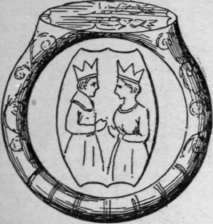
Rings would be exchanged just as to day, oaths given and finally, all of the groom's keys are given to the bride. The granted her the role as keeper of the household. The woman had ultimate authority on the storage of food and the well being of the household just as the man had the role of protecting the household from enemies.
Pronouncement
The Weofodthegn now having witnessed the vows pronounced the couple married
The Reception
Just as today the occasion of a wedding would be an excuse for a party. The Bride and Groom would share a loving cup to make their toasts to the Gods. Frigja and Freya. These were the most important to toast as they are the goddesses to ensure a good marriage. Now there would be a feast of the best food and drink.
Following the feast, there would be music and dancing and the usual entertainments. There is some evidence that in some tribes a race or brýdhlóp should take place. This was a race by the separate wedding parties to the new home. The party that lost has to serve the other at the next feast. Regardless, of who gets there first, the groom blocks the door, and carries or leads the bride across the threshold. So that tradition goes back a long time.
The morning after the wedding, the morgengifu needs to be given from the groom to the bride probably with witnesses.
The month following the wedding was called the hunigmonaþ from which we get our modern word "honeymoon." This was so named because for the next month, the couple would drink mead.
So some parts of these ceremonies we recognise today and some are less familiar.
A wedding ceremony will feature in Child of Loki (book 2 of the Northern Crown Series)
This article has taken material from the very useful http://www.englatheod.org website. That site studies and recreates ancient tradition of the years before the Christian Church replaced the Pagan religions of the Anglo Saxons.

April 24, 2011
Pregnancy and Childbirth in Anglo Saxon Times
Part of the Anglo-Saxon Survival Guide by Richard Denning

The goddess Freya protects a young mother
The process of pregnancy and childbirth in the darkages was fraught with danger. There have been estimates that around 10% of childbirths lead to death to mother or child. Deprived of effective medicine our ancestors therefore relived on superstition and belief in the gods.
We know about Anglo-Saxon cures and treatments and advice for health in pregnancy because of Leechbooks (a sort of compendium of cures) which survive into the modern period.
Infertility
Probably due to widespread malnutrition in pregnant mothers, infertility was a common problem.
There was no IVF ('test tube babies') in these days and no way of determining the cause. If a marriage did not lead to pregnancy there were however steps that a woman might take. Firstly if all else failed the laws of Alfred the Great allowed her to lay aside her husband if she did not become pregnant. Those laws date from a later period in the Anglo Saxon period but may have reflected earlier traditions.
Anglo Saxon medicine was crude BUT could be effective where a easily identified cause and treatment could be decided upon. Unfortunately in the case of infertility (and miscarriage) the treatments fall into the realms of superstition. The use of charms and spells to try and produce a pregnancy was common place. For example a woman who could not get pregnant would be advised to wear a hart's rib on her arm. Or she might try slicing up a hare's belly and mixing it into a drink. Another approach was to eat mushrooms and to rub herself all over with oils rather than bathing. Still another advised wearing coriander tied to the woman's leg.
General advice on health in Pregnancy
General advice regarding diet and behaviour in pregnancy was given. Pregnant women, particularly those with threatened miscarriages, should avoid riding horses and strenuous activity (pretty much all we can advise today). They should not eat sweet or salty food. They should reduce alcohol intake. Possibly the restriction on sweet food came about because Anglo Saxons doctors and midwives could taste the sugar in some pregnant women's urine (sounds gross, no doubt, to the reader but before modern testing sticks this was a method that had to be used until quite modern times) and and realise there was a problem. Today we would call it gestational diabetes.
In later period when Christianity had replaced paganism pregnant women were advised to write a prayer in Latin on a wax tablet and tie it to the sole of their right foot. It seems that it was more likely to cause them to limp then protect their pregnancy!
Miscarriage
One remedy for a threatened miscarriage specified in an Old English document instructs the woman to drink the heart of a hare, ground into dust and sprinkled with frankincense into a goblet of wine. She would have to drink this for up to thirty days. This remedy would be very expensive and completely ineffective.
Risk to the soul: In the later period women were threatened that if they miscarried their unborn child would never receive the forgiveness of Christ because they were never baptised and so THEY, the mother, would be responsible. This must have put the grieving mother whose pregnancy miscarried under even more distress.
Protecting from late or still births and deformities
Late births had their own medical risks and an overdue woman would be getting very anxious. Advice which probably dates back to the pagan period was for a woman to leave her house, take a handful of milk into her mouth, spit it out into running water, swallow the running water and then visit another house and eat something. This would be accompanied by a chant asking for a healthy birth.
In the Christian period the woman was to visit a graveyard, step 3 times over the grave of a man and recite as she did it "let this be my protection against loathsome late birth, let this be my protection against miserable still birth, may this be my protection against loathsome deformities at birth".
Physical charms
Amulets, strings of beads, rings and copper boxes which may once have contained herbs have been found in the graves of women and babies (sometimes buried together) suggesting the use of physical items to ward off the dangers of pregnancy.
Labour and Childbirth
There does not appear to be any evidence of much use of surgery such as forceps or caesarean section in labour at this time. Reliant of dubious superstitions and remedies the actual birth of a baby was a dangerous time for a woman.
If woman had a difficult labour they were advised to drink water in which parsnips have been boiled.
If the baby would not come forth or died and needed to be expelled the woman was to drink dittany juice. This was rare and probably not native to Britain, being of Greek origins, and so unlikely to be available. The Pennyroyal plant does grow here and interestingly is a uterine stimulant – in otherwords it would encourage a woman's womb to contract and push out the baby and so that remedy for once has some basis in science. It was also used to induce an abortion if the woman did not want the pregnancy and as a result Pregnant women were advised against taking it during earlier pregnancy.

Pennyroyal was used to cause Abortion or in labour
An ineffective and rather difficult to obtain remedy for pain in labour was to drink wolf's milk mixed with wine and honey. Quite how you were supposed to GET the wolf's milk is not explained.
Finally after the baby was born if the placenta or afterbirth would not come out the Leechbooks prescribed brooklime and hollyhock boiled in ale as a treatment.
Midwives
Illustrations from leechbooks dating from the later Christian period show women tending women in labour and it is likely that female relatives as well as actual midwives (women who became experienced and so were called in to help with labour) would be in the birthing room. Men are clearly NOT in the room in these images and childbirth was the domain if women.
In the earlier pagan period it may have been different. Scandinavian documents record the fact that often the father would be present at least at the birth or SOON after and would certainly come into the birthing room and be presented with the child. There seems to have been some ceremonial significance about him picking up the child/ taking it from the midwife as being the moment when he acknowledged the child as his own.
Death in labour
As has been said labour and childbirth was a dangerous time for the Anglo -Saxons. How do we know? The cemeteries that date to this period provide the answer. Firstly almost half of women buried in the Anglo Saxon cemetry at Raunds in Northamptonshire died between the ages of 17 and 25 – the likely time for childbearing. In the circa 7th century graveyard at Berinsfield in Oxfordshire the bodies of women under the age of 30 are considerably more that equivalent aged men. These graves also contain the bodies of many babies up to a few months of age as well as stillborn babies showing that life was full of danger for all involved in this process.
Thanks to the gods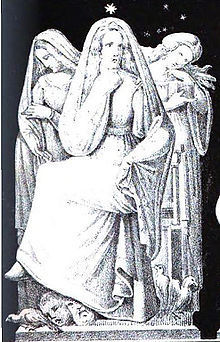
Praying to the gods was part of this entire process. The two goddesses of importance in the process were Freya and Frigga (possibly the same figure). Freya was the goddess of fertility whilst Frigga had power over pregnancy and childbirth so both were invoked along the way and thanked afterwards. Our modern day Friday is named after Frigga.
This belief was of course later replaced by attending church and giving thanks to God in the Christian period.
This article draws much material for Childhood in Anglo-Saxon England by Sally Crawford and A Handbook of Anglo Saxon Food by Ann Hagen.
This article came out of research I did for my Dark Age Novel The Amber Treasure and its sequel Child of Loki. It is presented in an Anglo-Saxon Survival Guide of similar material which all came from my reading and which I felt might be on interest to others.

April 9, 2011
Quick Guide to methods of self publishing a book
Self-publishing - How I did it at Mercia Books
So you have written your book and are looking to get it published. In brief there are several choices of how to do it:
Mainstream Publisher. Find an agent, impress him or her. They represent you to a publisher who likes your book, offers you a fat advance and takes your book and publishes it and then pays you royalties. You retire to the a sun drenched Island on the proceeds. This is the dream of course BUT it was always very hard to make this a reality and in these difficult times even more so. Put bluntly few publishers are taking on new writers and although it is absolutely sensible to try this route ( Get hold of the Writers and Artists Year Book to find listings of agents) it is very likely that even if you have a very marketable book you will fail to land a book deal. If you DO have a good book you need not give up hope. Read on.
Small Press Publishers. There are many little publishing houses who offer assisted publishing options. You approach them and they will still need to be impressed by your book and feel it is a marketable option. So even if they think a book is good but they don't think they can sell it they may reject you. Many of these publish 1 or 2 books a year so do not be surprised if they send you a 3 page rejection letter praising your book but saying it is not for them (I speak from experience here). If they do take you on it will be on the basis of NO ADVANCE payment and reduced Royalties. So only if the book sells with you get much from it. On the other hand they will offer professional services which may include editing and cover design (or you may have to do some of that yourself) and will sort out typesetting, printing and distribution for you and SOME marketing. Small Press Publishers are often interested in a NICHE area eg Welsh Poetry or Italian Romane Novels so research is needed. Check out: http://www.pw.org/small_presses
Vanity Press (Subsidy Press). The internet abounds with services offering to print your book for you for a upfront fee which is usually substantial. Quite often there is some offer of editing and cover design thrown in but the quality varies a lot. In many cases you will either have to pay a lot OR commit to buying say 50 or 100 books, at a cost of (for example: £10 to 20 each). They usually have NO distribution, meaning that they don't list your books in the ISBN databases NOR do they organise distribution via Amazon etc. They will normally do very little to publicise the books although they will often promise to. The way they make money FROM Authors and NOT from book sales so they don't care if you sell any books. The ONLY advantage of these services is that if you have NO IT skills at all you can get a book published but at a high per unit cost, often with limited come back if there are errors and with no support for sales or marketing. It's just cost you £1000 and you have a box of books, possibly printed upside down and that might well be it. This route is NOT advised.
Print on Demand. If you have SOME IT skills then a better option is the partial Self Publishing Route of using Lulu.com or Completely Novel or similar services. I used these services in late 2009 and Early 2010 when I was just starting out self-publishing. They offer an online service where you upload your word document (possibly preset to a certain page size) and they convert to the print ready PDF. You can design a cover online using stock art, upload a full cover or engage a cover artist. There may be a small cost per title to set it up but it will only be a few pounds. After that costs are ONLY accrued when you ORDER books from them. They have access to distribution networks (at an additional cost often) and will supply Amazon. The main draw backs are the PER UNIT costs are often high and you will have to sell your books at too high a price to be marketable. So they are a good option for short runs, where you just want a few books to give to friends or sell at clubs etc but not ideal if you are serious about attracting sales. Never the less a good way in to the self publishing buisiness and not a bad way to get copies in order to garner reviews on your books.
Self Publishing. Full self publishing is when you set yourself up as a Publisher, get your own ISBNs and get the books printed via a printer. There are some printers such as Lightning Source and Anthony Rowe which will ONLY deal with you if you are a Publisher. Once you are they will connect to the distribution networks directly for you. The other option is to get the books printed by any old printer and then handle distribution your self. The term Indie or Independant Publisher applies to small publishing concerns often individuals or small groups publishing just a few titles.
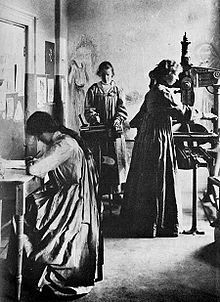
Above: A Small Press Publisher in 1903.
Mercia Books
A quick guide to becoming an Indie Publisher
So then about February 2010 I decided I was going to SELF PUBLISH. I was going to enter the work of the Independent publisher. How did I go about it. Well it was bumpy round but here are some pointers to make it easier for you.
Before you start publishing anything I strongly recommend engaging the services of a Professional Line editor. These will go through your book and help you polish it into a professional product. Your Aunt Flo does not count as she is A) Not objective and B)Probably not a Professional Editor. You can read about the sorts of skills that an editor brings and the type of errors she will look for here: Helen Hollick and JO Field's Guide to Polishing your manucsript. Jo is my editor and is superb. You can find a link to her on my website. http://www.richarddenning.co.uk
To further enhance the book you need a good cover artist. I use Avalon Graphics. Cathy there also did my websites and publicity material. You CAN judge a book by its cover and we all make our first judgement based on the cover.
Go to the Nielsen website and register as a publisher. http://www.isbn.nielsenbook.co.uk/controller.php?page=123 is the New Publisher page there. Nielsen handle registration as a NEW Publisher and also allocate your ISBNs. All books need International Standard Book Numbers if they are to be available on Amazon, show up on various biographical registers etc. For £118 you can become a Publisher and get 10 numbers. Just down load and fill in the forms. I found Nielsen very approachable and the lady I corresponded with really helpful.
Now you are a Publisher you need a printer. You can go and talk to local printers OR use a professional book printer. I use Lightning Source. A word of caution here. Lightning source is NOT for novices, You MUST be able to supply Print Read PDF using Adobe Professional not just a Home version. See http://www.adobe.com. This means you have to be able to FORMAT the word document to size it right. Lightning source will not talk to you if you are not a publisher and even then they will try and persuade you to use Lulu or someone else. But if you convince them that you have the skills and ability to cope then they take you on. You will have to sign contracts to set up payment routes as well as distribution agreements in the UK, UK and Europe.
Download and read the extensive notes and guides on the LS site on converting WORD to PDF, how to set up titles etc. Ready to set up a title here we go:
Setting Up Title
1.Click on Library, set up Title. Select Full Distribution OR Print to Publisher (the first if you want to access Amazon etc). Then fill in this page with books Name, author etc.:
2. Go onto the next page where you have to set up the books size and type – paperback or Hardback, choose the price and set up the description and options for where you want it available.
3. When you have done this get onto the cover artists and send them a template. Once you have setup the title LS will generate a cover template with the ISBN in and bar code etc. Send that to the artist.
4. Open your word document. Its probably in A4 size. You need to set the size to match the dimensions of the book you just set up on LS. Set margins to maybe 13mm, make sure you have a gutter (the wider bit of the page that is always on the side. Make sure that you set up the book with mirror pages. Play around with fonts for your titles, page number styles and location etc. Make sure the book STARTS on the right hand side and all chapters start on a right side page. make sure the text is Justified – aligned to left and right . Only having text left aligned is a sign of an amateur (my early books did that!!). Then PRINT to PDF but go in and change settings as per the LS instructions on PDF format. This is where you need Adobe Pro. Make sure Fonts are embedded.
5. Upload the PDF and the cover PDF to your title and submit. LS will crunch the files for a couple of days and then the title will show up as Proof Approved assuming there are no issues). Order a proof (£21 cost)and in a few days you have a copy of you book. Approve the title and in 2 weeks it shows up on Amazon but you can immediately order copies from LS. Get started with promotion and linking in Sales buttons on your website (a whole other subject)
How much does it costs to take this approach?
Setting Up costs: Buy cover design off Artist (price ? £100-£400)
Cost of editing by editor (£250 to £500)
(Lets say £500 for above – you CAN get cheaper but have to be sure about quality)
Purchase ISBN c £10
Setup cover cost at LS £21
Setup Book Block cost at LS £21
Keep ISBN on catalogue at Lightning Source £7 (per year)
Get into Ingrams catalogue £20 for UK and same for US = £40
Order Proof x 1 = £21
Setup costs = £620.
Then cost of printing a book would be somewhere between £2 and £8 dependant on the length, type of books and the quantity you order. Offset printing is traditional stype printing. It is VERY cheap per unit if you can sell 2000. But if you can you can print at £2 or so per book.
If you only want say £100 books you might be looking at £4 for a 350 page book.
At first glance you might say "Hang on a minute, 100 books just cost you £1020. Thats the same as that Vanity publisher - what's the advantage?"
Well a lot of that £1000 I spent via Mercia Books went on a professional edit and a good cover so I am happy that quality is good. I also have full distribution and my books will show up on Amazon and CAN be ordered by book shops if desired. Best of all I am in control. Every aspect of the process I can monitor. If I don't like the cover I tell Avalon etc
You can see my books via my author page here: http://www.richarddenning.co.uk/
Or Via Mercia Books here: http://www.merciabooks.co.uk/

March 30, 2011
Shedding light on the Dark Ages
Evidence and guesswork in the 6th Century
Some of the historical fiction which I have written is set in a remote and obscure period. Writing about the late 6th and early 7th century in The Amber Treasure puts you right in the middle of the darkest years of the Dark Ages.
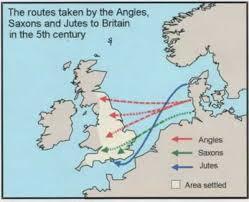
When the last Roman soldier departed Britain in about 417 AD reliable documentation of events started to collapse. The invading Anglo-Saxon tribes were effectively illiterate and it was not until the coming of Christianity (which did not fully pervade England until the late 7th century) that some form of regular record keeping returned. It really took until the time of Alfred the Great at the end of the 9th century for reliable continuous commentaries on the goings on in the land to be kept in the form of the Anglo Saxon Chronicle and other documents.
What then do we do when we want to find out what happened in the early Saxon period? Where could I turn to when writing a book set in the late 6th century?
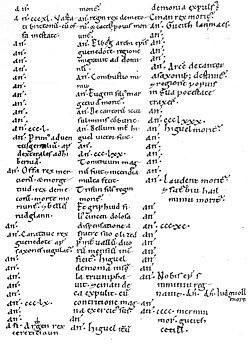
The documents that I turned to when trying to found out what historians knew about this period were:
De Excidio et Conquestu Britanniae On the Ruin and Conquest of Britain) by Gildas. Gildas was a monk who lived around AD 500 to 570 in the Dumfries area of Scotland (what was then the British Kingdom of Strathclyde). Much of what we know about the possible existence of Arthur, Vortigern, Ambrosius and so on comes from Gildas. His writing shows the state of chaos and confusion with a land split between half a dozen races and the civilization that had persisted for four centuries collapsing. There are limits to Gildas however. Firstly he had a message to pass on. He wrote about the downfall of Britain – the end of Roman rule and the invasion of the Anglo Saxons and very much argued that this was God's punishment for their sins. More importantly he died around AD 570 – JUST before the period I was writing about.
The Historia ecclesiastica gentis Anglorum: Ecclesiastical History of the English People by Bede. Bede was a late 7th and early 8th century scholar and monk. His main work is believed to have been completed in 731. Bede writes a lot about the ancient (to him) history of Britain and basically stopped around the fall of Britain and the end of Roman rule, picking up the story with the Augustine mission in 597. He only really gets interested in the conflict between Celtic and Roman Christianity and the conversion of kings and very much argues that the defeat of the Britons is the result of them backing the wrong horse (theologically speaking). So he was quite content to report Pagan English slaughter of Welsh monks as being justified for example. All that said he has a lot of detail from the early 7th century onwards BUT there is an agonising gap before about AD 600.
The Historia Brittonum, or The History of the Britons, is a historical work that was first composed around 830 by the Welsh Monk Nennius. It contains a lot of of detail on the Arthurian period and some full genealogies of the Royal Families of Deira and Bernicia but again there is an annoying lack of commentary on the late 6th century.
Annales Cambriae, or The Annals of Wales, and other Annales in Ireland and Scotland are chronologies and lists of dates compiled in the 8th to 12th centuries in various monasteries and then combined together. They offer snippets and brief glimpses of events - particularly brief the further back you go. Names come up, some useful dates but very little detail. It its like looking at the contents page of history text book! Scholars though can study all these fragments and combine them into something approaching a coherent history and these add some knowledge.

The Anglo Saxon Chronicle (late 9th century and afterwards)
Probably started by King Alfred the Great who at least sponsored and encouraged it, this was a chronicle of events in England and surrounding lands recorded by monks. It focuses on the large events, battles, Kings and Lords and so forth and at first glance would seem to be just the thing. BUT there are limitations to its usefullness. The writers were living in a period over three hundred years after the events they recorded and so were relying on passed on word of mouth or old documents that no longer exist and we cannot validate. Moreover the Chronicle is south centric – focusing for the most part on the events in the southern kingdoms and little on those in Northumbria where my story is set. This is so much so that the chroniclers seems to just simplify matters by lumping the Royal Houses of Deira and Bernician (the two parts of Northumbria) into one. Fortunately other geneaologies do exisit for this period. The historic Battle of Catreath which did so much to shape the north is not even mention in the ASC. Then again it is not mentioned in many places.
Welsh Poetry
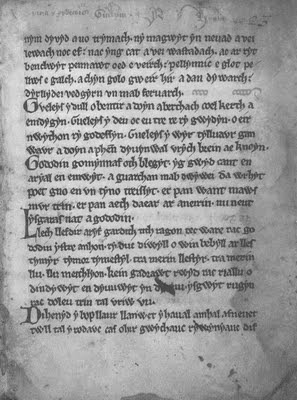
Oddly enough it is poetry, not historical documents, that shed some more light on these dark years. The British poets and bards Aneiren and Taliessen witnessed or heard about the great and traumatic moments of the late 6th century. To them it was real life, happening to them and those they knew. Taliessen lived circa 534 to 599 and wrote about Urien and Owain of Rheged. Much of what we know about the struggles between Bernicia and Rheged we read of in his poems. Aneirin was younger - possible a young man in 597 at the battle of Catreath and it was his poem about it – Y Goddodin that is really the only record of the event.
Making sense of it all
This then is the problem that writers of historical fiction set in the late 6th and early 7th century have. There is something like a 150 year gap in reliable data. You just have to examine it all, visit the possible battlefields and locations that are known about and make the best effort to create a believable world, to bring to life those that lived in these forgotten but critical years – the birth of England.
I hope I have achieved this in The Amber Treasure.

March 26, 2011
Spring Newsletter
My spring Newsletter is out now with news on Pre orders for Yesterday's Treasures, the New edition of The Amber Treasures plus lots of up coming events of interest to lovers of books and games. Go to http://mim.io/5af7f to read it.

March 20, 2011
Using Virtual Blog tours to promote books
What I learnt on my first Virtual Book Blog Tour
by Richard Denning
From 31st January until the 17th of March I embarked on a Virtual Blog Tour. Now it is over I thought it might be worthwhile feeding back some thoughts on how it went. Here then is a quick guide to what I did.
Finding the blogs. Tomorrow's Guardian is Young Adult Time Travel Fiction so What I did was to google terms such as Young Adult Fiction Blogs , Sci Fi book blogs etc. So firstly you need to identify your target audience. There is no point having the blog tour take in gardening books blog sites if it is Sci-Fi as the readers of those sites wont be interested. I then trawled through the sites looking for appropriate ones that matched the sort of book I was promoting.
TIP: There is a useful site that lists Blogs willing to review books. On the site he lists many blogs but also sells a 99cents pdf which is well worth the download as it contains a nice little reveiw of each blog with an idea of their policies and numbers of followers. http://www.stepbystepselfpublishing.net/book-reviewer-list.html
So now I looked over the sites and established how many followers they had. I had no problem doing a blog on a small site or new site as I saw it as me helping them as well as them helping me BUT it makes sense to focus your tour on sites with hundreds of followers (or more). Many of these sites list the numbers of followers they have on Facebook and Google Friends or Twitter.
Find the policy page. Most blogs will somewhere have a page that states what their policy is on doing book reviews, giveaways, hosting guest posts etc. They may also say whether they have any problems looking at self/ independently published authors. Some get snooty about this. Others are open to looking at anything. Some will say that they are busy at present and can't take new books till they clear their backlog. If in doubt locate an email address and send them a query. This can at times be hard as some blogs make it difficult to contact them.
Email the Blog. I sent a press release about the book with short blurb, cover image and if possible some existing reviews or links to the Amazon page if it has reviews on. I politely asked about the possibility of them reviewing the book. Then I offered to take part in giveaways (ebook giveaways cost you nothing if you have done your own conversion, paperbacks cost you a few quid but I see this as an advertising expense) and also to provide them with content by way of a guest post. Most blogs will lap up guest posts. Make them interesting but linked in some way to your book.
You can tell a lot from how quickly they respond to the email and if you send a follow up query how quickly they come back on that. Some site owners just put up a site, review 2 or 3 books and loose interest. Some owners agree to review your book and then fail to post a review or even to reply to emails. There is no easy way to pick this up apart from trial and error and I have already started drawing up my own list of good sites and bad sites. Once you do have communication going back and forth I offer a few dates to the blog owner. Try and give them at least 4 weeks notice and probably more like 2 months. Everyone has busy lives and people need time to read and review a book. I also agree about giveways, deadline on any guest post submission and also try and get an undertaking for the reviews to go up on Amazon and Goodreads as well as the owner putting it out on facebook.
I collect the various blog dates into a tour itinerary and when it is fairly full publicise the dates. Get that on your website, Facebook and Twitter.
Write all your guest posts. Try and get them done way before the actual tour itself. Tuck them away and when called for email the Blog owners. They will often come back and say "all set up and scheduled to run". A few days before each blog post/ visit I email them and check all is ok.
On the day of the post I see that it is up and then link to the PERMALINK. That is the actual individual address of the post NOT the Blog's own URL. Usually if you click on the title of the post and save that address this will be a permanent link. I put that link on my website as well and now drop in a mention on Facebook and Twitter.
I follow up the visit with a thank you email and keep the channels open for a return visit.
Ideally I would then make some notes about each site so I can remember what went well and what not so well. Sometimes a Blog NEVER appeared on the agreed day. I usually follow that up with a polite "hope everything is OK" type message. If I hear nothing I send another similar message. Then I drop it and leave it to them to come back and make a note not to use them again.
Does it cost?
Well the short answer is "it depends". There are a number of sites that now ONLY take e-books. If you have done your own e-book conversion it costs nothing other than your time. If you need to supply paperbacks to say 20 sites then that will cost a bit BUT just think a moment. If you place a single advert anywhere you will spend quite a bit of money. £7 to £8 to post a paperback to some one (including the book cost) should be seen as advertising expense in my opinion. I treat giveaways the same. Keep the numbers manageable though. I usually offer 1-2 paperbacks and 5 e-books.
So was it all worth it?
Time will tell. I have had reasonable (if not stellar) sales of paperbacks and e-books during the blog tour. Reviews you gathered and guest posts sit on the internet and provide ongoing advertising for you.
TIP: set up Google Alerts. You can specify various words and phrases such as "Tomorrow's Guardian" or "Richard Denning" and then each day you get an email telling you if and where those terms come up. Many are not relevant but I find I pick up on many mentions of topics I want to know about and find reviews and comments and even forum posts and discussions. That way you can automate some of the monitoring of the internet but still keep an eye on what is going on.
Promoting and selling books is an on going and very hard task. The new world of publishing that the internet and ebooks allows has made it possible for small press, independent authors to get their books out there. But we need to be onto everytrick there is to help that process. Doing a Virtual Book tour is one of them.
Check out my own tour here:
http://www.richarddenning.co.uk/blogtour.html


